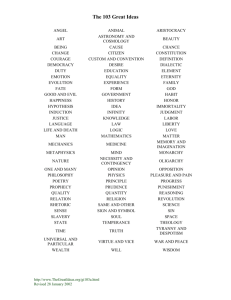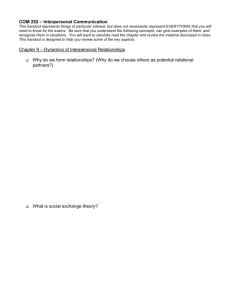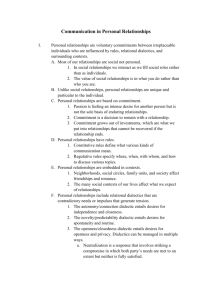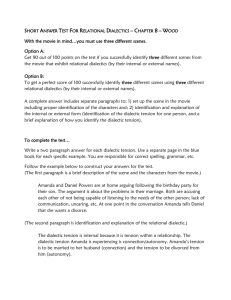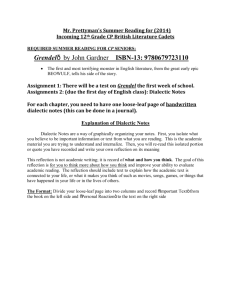File
advertisement
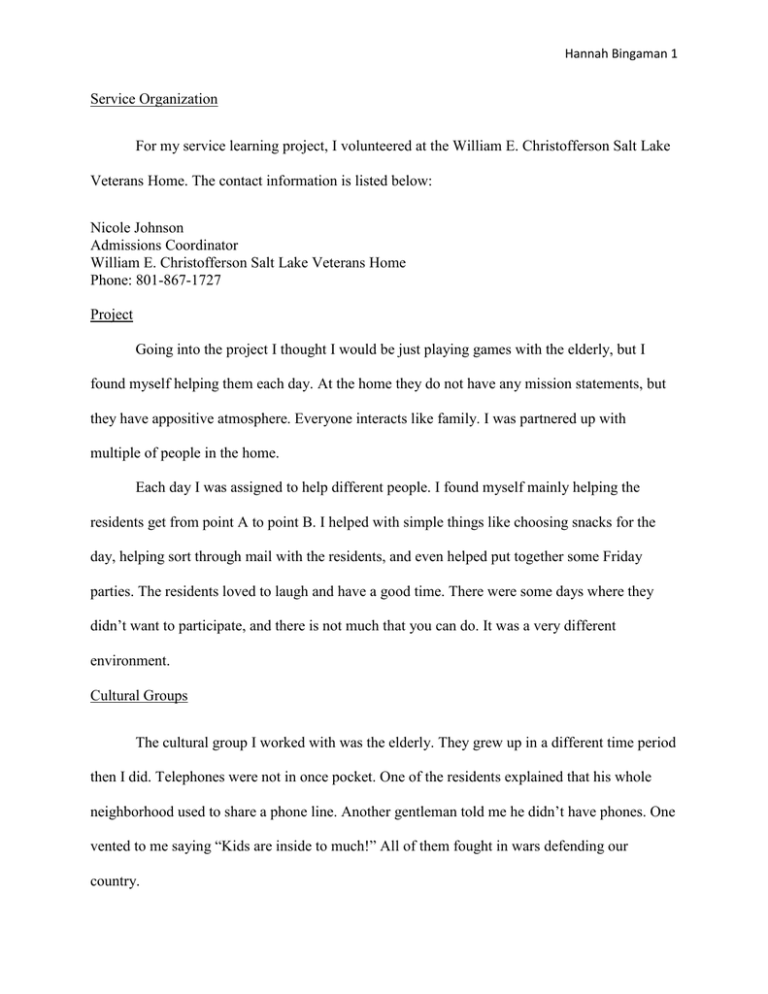
Hannah Bingaman 1 Service Organization For my service learning project, I volunteered at the William E. Christofferson Salt Lake Veterans Home. The contact information is listed below: Nicole Johnson Admissions Coordinator William E. Christofferson Salt Lake Veterans Home Phone: 801-867-1727 Project Going into the project I thought I would be just playing games with the elderly, but I found myself helping them each day. At the home they do not have any mission statements, but they have appositive atmosphere. Everyone interacts like family. I was partnered up with multiple of people in the home. Each day I was assigned to help different people. I found myself mainly helping the residents get from point A to point B. I helped with simple things like choosing snacks for the day, helping sort through mail with the residents, and even helped put together some Friday parties. The residents loved to laugh and have a good time. There were some days where they didn’t want to participate, and there is not much that you can do. It was a very different environment. Cultural Groups The cultural group I worked with was the elderly. They grew up in a different time period then I did. Telephones were not in once pocket. One of the residents explained that his whole neighborhood used to share a phone line. Another gentleman told me he didn’t have phones. One vented to me saying “Kids are inside to much!” All of them fought in wars defending our country. Hannah Bingaman 2 Challenges The challenges I had during this project was not entirely communication. Yes, I found myself repeating myself, and yelling so they could hear me, but majority of my challenges had to do with being patient. It was difficult to wait to get to one place to the other. Where it would take normally only 15 seconds to stand up it takes them about 2 whole minutes. I found myself taping my foot impatiently and forgetting that they were older. When helping the residents load into their vehicle it took up to 30 minutes. And going to the movies was an all-day event. Things were a lot slower pace and they were very direct. If they didn’t like something, they would tell you. I think another challenge was, how blunt they were with one another. One older man yelled at me because I gave him a pina-colada margarita instead of strawberry, it was so bad that I almost broke into tears. Soon after he got the right one he was back on his feet and happy; like nothing happened. Theory The theory I would like to focus on is Relational Dialectics Theory developed by Leslie Baxter. This theory is interpretative. It is about relationships within and outside of the culture. In our course packet it states “Relationships have many dialectical tensions that are at work.” There are six different types of dialectics: Cultural-Individual Dialectic, Personal-Contextual Dialectic, Differences-Similarities Dialectic, Static-Dynamic Dialectic, History/Past-Present/Future Dialectic and Privilege-Disadvantage Dialectic. The first dialect I would like to discuss is Cultural-Individual Dialect. According to our texts books, Intercultural Communications in Contexts, communication is both cultural and individual. There are characteristics that we will pick up from our cultural, but there are Hannah Bingaman 3 characteristics that are our own. (Martin and Nakayama, 2004,pg. 77) For example, in my family all the girls danced. It was something that was part of my families culture. We all loved to dance and watch people dance. Each one of us had differenet styles of dance. Jessica danced differently from Gretchen, and I danced differently from Gretchen. We had our own individual styles, but the culture of dance was the same. The second dialect I willl look at is Personal-Contexual Dialectic. This dialect looks at the role or social status one may hold in their culture. In different cultures, and different atmospheres one will be looked at and respected differently. For example: In high school I was in Student Government. Many people turned to me for ideas, and help. In that culture, I was looked up at. At home my father was the one we turned for ideas, and help. It was a different culture of how things worked. (Martin and Nakayama,2004, pg 77) The third dialect is Differences-Similarities Dialectic. When comparing cultures we tend to look at the differences in each culture. This dialect is telling us to not only look at the differences, but the similarities as well. (Martin and Nakayama,2004, pg. 77) The fourth dialect is Static-Dynamic Dialectic. This dialect discusses how most aspects of cultures remains the same, but there are some aspects that may change over time. (Martin and Nakayama,2004, pg 78) For example: Many years ago family parties consisted of entertaining the children. The childrens table was always larger than the adults. But now it’s the opposite. Our culture is the same, but that aspect of how family parties used to be held has shifted over to entertaining adults. The fifth dialect I would like to discuss is History/Past-Present/Furture Dialectic. This dialect reminds us to keep in mind the culturals past, present and future. Judith Martain and Hannah Bingaman 4 Thomas Nakayama state that “ we need to be aware of contemporary forces and realities that shape interactions of people from different cultural groups.” (Martin and Nakayama,2004, pg. 78-79) The last dialectic I would like to explain is Privilege-Disadvantage Dialectic. This dialectic takes into account those percpectives of people who may be privledged in their culture, and those who may have a disadvantage. Our text book gives a great example of this; it explains that many people who travel are privledged, because they have money . But they could be at a disadvatage, because the might not know the language. (Martin and Nakayama, 2004, pg. 79) Analysis My service learning applies to a coule of these dialectics. I thought it would be difficult applying my theory to my project, but in reality it fits right in. There are couple theories that I would like to apply my service project to. The first one is Cultural-Indiviual Dialectics. In my service learning project the residents home had its own culture, but each resident brought something new and intiving to the home. You had Art who collected all the snacks, Clair who loved to sing, George who loved winning, but hated working, and Ray who loved the ladies. They all were in the same enviroment and same circumstances, but individually they were different. Another example that fits right into theses dialectics is Differences-Similarities Dialectic. Many people look the sterotypes of “old folks homes”. They look at the smell, the slow pass, the repeditiveness and hearing aids, but in reality they don’t look at the similarites to their own lifes. Many of those sterotypes are true, but in the home they play games, throw parties, go grocery shopping, have family dinners, attend church, and pay bills just like any other Hannah Bingaman 5 adult would do. They may appear old physically, but they are young in the heart, especially Ray. He loved to look at the ladies bums, and dance all day. He reminded me of a pervy teenage boy, but he could get away with it because he was old. The last example I would like to connect my service learning project to is History/PastPresent/Future Dialectic. In order to really understand these people in the home you must understand their history. It’s important to understand that they come form a different time period, and they might not understand the slang that is used now. Many of the residents have been through war, so many times they will mention things from the war. It almost takes you back in time. But you have to understand that these people have been through life already, things we as young people are currently going through, they have been through and maybe even more. As I look back it was really interesting to analyisis my service learning procject with these dialectis. It made me realize that even though people come from a different background or time period we all have some common ground. Reflection Entering into this project I was scared and I was dreading the thought that some of my free time was going to be taken up, but in the end I loved every minute of it. These people have been through what I am going through already. And they can relate to you. They may seem old,but they are young at heart. Going into the project I forrced myself to put on a smile, but as the days continued I found myself going in each day with not having to force a smile. The people made me happy to be there, and not all old people are grumps. Hannah Bingaman 6 When applying the theory I first found it difficult, but as looked for those common grounds I realized any theory could be applied here. You just have to dig. I would love to continue to go back and volunteer again. Those people made me laugh and feel good about myself. It taught me to not judge one by a stereotype. One may be in a culture that has many negative stereotypes, but you don’t know the whole story. You personally don’t know their story. You should respect them and their background. References Martin, Judith N. and Thomas Nakayama. "Intercultural Communications in Contexts." New York: McGraw Hill, 2012. 74-79.
